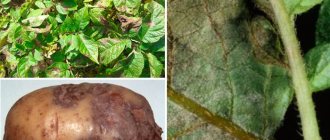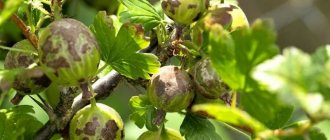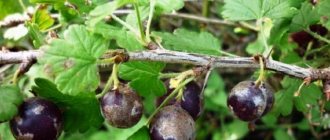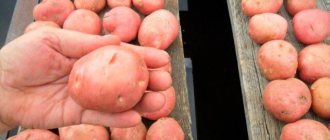Potato scab
Scab is one of the fungal infections of potatoes. But unlike other diseases, it does not lead to the death of the plant. Scab appears during the formation of tubers and persists throughout the growing season. Small brown spots first form on the tubers. They grow, turning into growths and ulcers.
With severe infection, the entire potato becomes covered with a solid crust and takes on an unattractive appearance. Such potatoes are immediately discarded and not stored, as gray and dry rot will quickly develop on them.
With minor signs of disease, tubers can be used for food and livestock feed.
Types of potato scab
Common scab
The most common type. Characteristic signs are the presence on the surface of tubers of shallow ulcers of concave, mesh, convex, flat shape. Changes can affect not only the peel, but also the pulp of the tubers, stolons with roots.
When convex, the ulcers resemble warts. When concave, the bottom of the spots is pressed into the tuber, and the edges are raised. Flat scab affects the skin or surface layer of young tubers. They develop rusty-brown ulcers. Net scab is distinguished by the fact that small intersecting depressions appear on the surface of the tubers, similar to a net.
Silver scab
First, sunken shiny dark gray spots with an easily erasable coating form on the potatoes. During storage, the skin of the tubers peels off. Air penetrates there, and the affected area turns silver.
Lumpy scab
Signs of this species appear 4–5 months after the crop is stored. The tubers are covered with small brown tubercles. They are capable of growing together in groups of 4–5. The peel becomes wrinkled and peels off. Potatoes can be simultaneously affected by silvery and lumpy scab.
Black scab
Black scab on potatoes
This species appears on tubers, stems and roots. Easily scraped off black growths form on the tubers, looking like lumps of stuck earth. Over time, weeping spots form in their place, damaging the eyes and sprouts.
Depressed brown spots and ulcers appear on the stems and roots.
Powdery scab
The main signs of powdery scab are the presence of large light warts filled with a gelatinous substance on the tubers. When the peel is damaged, it turns into a brown spore mass. In place of the warts, there remain ulcers slightly deepened into the pulp with ragged edges.
White and then gradually darkening growths cover the roots, stolons, and stems.
Powdery potato scab
Unlike the common variety of fungus, which prefers dry soil, powdery scab is a consequence of the action of the pathogen Spongospora subterranean. The fungus settles in waterlogged soil and can remain active for up to five years. The optimal conditions for its appearance are considered to be temperature limits from 10°C - 12°C.
Signs
Among the main external symptoms of the disease description characteristic of the powdery variety:
- covering the stems with white growths,
- the appearance of multiple red-brown warty growths of different sizes on potato root crops.
Spreading
Powdery scab affects both tubers and plant stems, mainly their lower part. Fungal pathogens are transmitted through organic residues preserved in the soil, but can also spread by air. Damaged tubers usually dry out during storage, but with high humidity in the room they begin to rot.
Factors contributing to the spread of the powdery form of the disease are rain.
Prevention and treatment
Among the potato varieties resistant to this type of fungal disease are Cardinal, Majestic, and Yubel. In order to prevent against powdery fungus, gardeners often soak the grown seedlings in a formaldehyde solution for 5-7 minutes before planting them in soil, subsequently covering them with a tarpaulin for several hours.
Causes
The disease actively develops in the dry, hot season. The infection most often spreads through the soil. It has been noticed that in slightly acidic soil, potatoes rarely get sick, but when grown in sandy alkaline soil, the tubers are more affected. Therefore, the outbreak of the disease is facilitated by excessive application of ash and unrotted manure to the soil.
Scab is transmitted through infected planting material and plant debris left on the site, in which the fungus persists.
Another reason for the spread of the disease is improper storage conditions: high humidity and air temperature in the basement, accumulation of a large volume of tubers in one place with poor ventilation.
The causative agent of the disease
Scab is caused by fungi that live in the soil. They do not attack the tops, but the tubers, penetrating into them through even the smallest cracks in the peel. It is extremely rare that damage to the root system and shoots is possible.
Important!
Unlike other fungal diseases, scab does not cause the death of a potato plantation, but it deteriorates the quality of harvested tubers and reduces the yield of this vegetable crop.
In diseased potatoes, the appearance and taste of the tubers deteriorate. They reduce the starch content by about 1/3, and the harvested crop is stored much shorter than expected.
Photo of scab on potatoes
The danger of this disease is also that it has several pathogens, depending on this, the types of scab differ
. And, accordingly, preventive measures and ways to combat it will be slightly different.
Potato varieties resistant to scab
Zhukovsky early is an early ripening drought-resistant variety. Pink tubers with excellent taste.
Spring White is an early ripening variety with white tubers. These potatoes keep well.
Lugovskoy - in addition to disease resistance, the variety has many advantages: it ripens early, is unpretentious in care, produces consistently high yields, and is stored for a long time.
Elizaveta is an old high-yielding variety with tasty white tubers. Suitable for cultivation in the Middle Zone, North-West, North Caucasus and Far East.
Temp is a high-yielding, late-ripening variety. Tubers with creamy pulp for universal use. Potatoes keep well.
Find out more about other popular varieties in the article “The Best Potato Varieties.”
Description of the disease and types
Scab is a fungal infection and is found in all regions. It mainly affects crop tubers, so it is difficult to determine the infection at the initial stages. Result of infection:
- deterioration in the taste characteristics of potatoes;
- deterioration of the peel, due to which the commercial properties of the product are lost;
- reduction in starch content (up to 25-30%);
- risk of potatoes rotting during storage;
- deterioration in keeping quality.
Often, when harvesting, gardeners do not even pay attention to tubers with small tubercles, spots, and flaky growths (see photo).
But already in winter the taste of some potatoes sharply deteriorates, and by spring the loss of seed tubers is noticeable. Without timely treatment, varieties degenerate and yields decrease.
Means of struggle
Chemical and biological drugs
Agat-25
Seed potatoes are treated with this growth regulator before planting and the bushes are sprayed at the closing stage. To spray 50 kg of tubers, prepare a solution at the rate of 7 g of biological product per 500 ml of water. Consumption rate for treating bushes on an area of 100 sq. m – 1 g per 4 liters of water.
Fitosporin M
The tubers are treated with a biofungicide before planting (10 g/5 l of water per 20 kg of tubers) and the bushes are watered at least 3 times per season.
Maksim
The drug is used twice: in the fall before storing seed potatoes for storage (2 ml per 50 ml of water) and in the spring before planting (4 ml dissolved in 50–100 ml of water). The tubers should dry after spraying.
Quadris
The soil is sprayed with fungicide before planting the tubers. 3 ml of suspension is diluted in 10 liters of water. 1 liter of solution is enough to treat 10 square meters. m. The protective properties of the fungicide are maintained for 2 months.
Prestige KS
The drug is used to treat tubers before germination. Use 70–100 ml of water fungicide per 1 liter of water. 100 kg of tubers are treated with this solution.
Traditional methods
- A nutrient mixture consisting of 60% compost, 20% pine needles, crushed cones, sawdust and 20% nitrogen-phosphorus fertilizer has a healing and preventive effect.
- In addition to fungicides, boric acid can be used to treat planting tubers. Seed potatoes are sprayed before germination with a 1.5% boric acid solution.
- Mustard kills fungi and disinfects the soil. It is sown, and when it grows, the soil is dug up along with the green mass. Some gardeners scatter ready-made mustard powder between the bushes, and then water these places.
Types of disease
Translated, the name of this fungal disease means husk, scab
. That is, this disease is characterized by the occurrence of various lesions on the skin of tubers.
Reference!
The cause of scab on potatoes is certain soil fungi, which are highly resistant to periods of drought or severe frost, and they can live in the soil for quite a long time.
Depending on the types of pathogens, this disease is divided into the following types:
- ordinary;
- black;
- powdery;
- silver;
- tuberous.
Prevention measures
The main method of preventing scab infection is the selection of high-quality seed material and its pre-treatment with fungicides. Only potatoes free of spores can produce a high-quality harvest, provided that the soil for planting has also been pre-treated with drugs against fungal infections. In addition, the following measures can be taken:
- Grow between rows of green manure - mustard, lupine and peas protect the soil from fungal spores.
- Store the crop only in a cool and ventilated area.
- Grow scab-resistant varieties.
- Maintain crop rotation.
These methods will preserve the harvest and protect the soil and seedlings from damage by fungal spores.
Preventive actions
- Scab pathogens are resistant to unfavorable climatic conditions, so they live in the ground for more than 4 years. Therefore, it is necessary to begin the fight against the disease with preventive tillage.
- These fungi primarily live in alkaline soils, so you should not use wood ash as a top dressing. Nitrogen fertilizers provoke the development of fungi, so the amount of preparations applied to the soil should be minimal. You should also not use fresh or partially rotted manure as a top dressing.
- To improve soil fertility and reduce the risk of scab, use fertilizers that contain potassium, phosphorus, copper and bromine. Water-soluble manganese and humus are also used as fertilizers.
Important!
To acidify alkaline soils, they can be spilled with a solution of ammonium sulfate (2 tablespoons of the drug per bucket of water).
If the harvested crop contained tubers affected by scab, then it is not advisable to plant potatoes in this area for 5 years
. For preventive purposes, the soil needs to be treated. It is recommended to plant green manure on the site, and before the onset of frost, dig up the site using a spade.
Folk ways to combat scab on potatoes
The main ways to combat this disease include:
- compliance with crop rotation rules;
- carefully select tubers for planting;
- observe the irrigation regime, destroy weeds and apply the necessary fertilizers on time.
It is also recommended to cut off all the tops 12-14 days before harvesting - after this, the skin of the tubers is strengthened, which additionally protects them from scab.
The best potato varieties for the Moscow region and the middle zone
If scab does appear on a potato plantation, then the following measures need to be taken:
- After digging, the tubers are sorted. If they are slightly damaged by scab, then after appropriate treatment they can be eaten. But they cannot be used as seed material.
- After the crop is dug up, the soil is sprinkled with mustard powder and watered abundantly.











